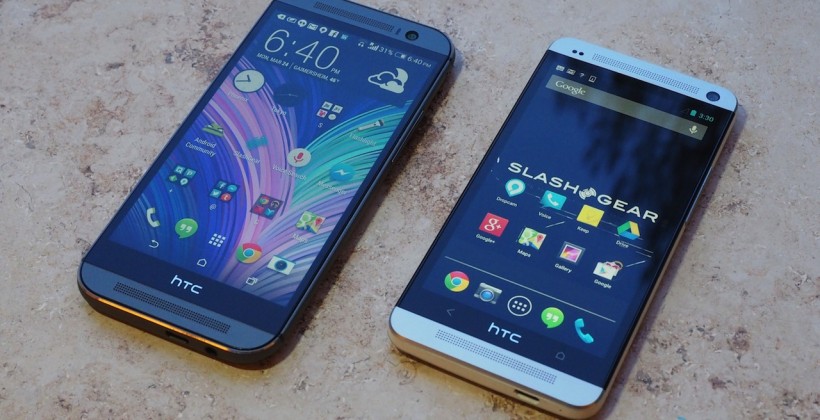HTC One M8 VS HTC One M7: Is It Worth Upgrading
BY yuki | 三月 29th, 2014 | 1 | 0
With a stunning look, the HTC One M7 has gained many supporters in last year. And now the new HTC One, called HTC One M8 was released in this month. It combines great performance with a stylish body, in the hope of causing a new stir in the Android group. Is the HTC One M8 impressive enough to catch more attentions? Is it worth upgrading? Let’s compare the HTC One M8 with its predecessor HTC One M7 step by step to find out whether it is worth upgrading.
HTC One M8 vs HTC One M7: Design
While the two devices outlooks are similar, we still need to take a closer look. The two HTC One share the metallic straight sides and rounded corners. In terms of weight and thickness, the original HTC One measures 68.2 x 137.4 x 9.3mm and weighs 143g and the new HTC One is slightly thicker and heavier by measuring 146.4 x 70.6 x 9.4 mm and weighing 160g. The new HTC One M8 outweighs original HTC One at its chassis made from aluminum at glossy finish now wraps around to the front of the body.
HTC One M8 vs HTC One M7: Display
Featuring a Full HD 1920x1080 pixel at the density of 469 ppi, the 4.7 inches screen of HTC One M7 does not make it difficult to hold in the hand. The new 5-inch HTC One M8 screen is bigger, but it remains the same 1920x1080 pixel at 441 ppi. Therefore, the original HTC One has a marginally sharp screen, while the contrast ratio and viewing angles of the new HTC One M8 are better.
HTC One M8 vs HTC One M7: Processor
Taking the advantage of Qualcomm APQ8064T Snapdragon 600 clocked at quad-core 1.7GHz Krait 300 and 2GB of RAM, it runs fast. For the new HTC One M8, it has a co-processor like iPhone 5S. It performs better by a Qualcomm Snapdragon 801 quad-core (Krait 400) processor with HTC co-processor running at 2.3GHz plus an Adreno 330 GPU with 2GB RAM.
HTC One M8 vs HTC One M7: Battery Life
After all these years, smartphones’ battery life is still one of the biggest pain points. Is the battery life of HTC One M8 improved? Both original HTC One M7 and HTC One M8 have a removable battery. The previous generation HTC One battery has 2300mAh capacity rated at 8.5Wh. It can last up to one to two days at an average usage. For the new one, it includes a larger 2600mAh battery and an Extreme Power Saving mode. According to HTC, the device can last for up to 30 hours on just 10 percent of charge.
HTC One M8 vs HTC One M7: Camera
The HTC One M7 rear-facing camera is just rated at 4 MP. It can capture 1080p video at 30fps. The new HTC One primary camera also shares the same specification, but is it special by its Duo camera. The main Ultrapixel camera performs as normal, and the second sensor has the function of capturing depth information, which helps HTC One users refocus shots. Different from the original HTC One 2.1MP front-facing camera, the new handset is superior by its upgraded 5MP wide angle front camera.
From the aforementioned comparisons between HTC One M8 and HTC ONE M7, it’s easy to tell no many outstanding changes on the new device. Whether it’s worth upgrading your HTC One M7 to the new HTC One? If you are smartphone fever and pursue a more powerful device and don’t care about the price, it’s not bad to have a new version with better specs. But if you think the original HTC One M7 spec are enough for you, then just keep it and forget the upgrade.
How about you? Will you buy a new HTC One? Do you think it is worthy of an upgrade? Please let us know your choice in the comments.
|
HTC One (M8) |
HTC One (M7) |
|
|
OS |
Android 4.4.2 KitKat (out of the box) |
Android 4.4.2 KitKat (via software update) |
|
Display |
5.0" Super LCD3 |
4.7" Super LCD 3 |
|
Resolution |
1920 x 1080px (441 ppi) |
1920 x 1080px (469 ppi) |
|
Height Width Thickness |
146.4 mm 70.6 mm 9.4 mm |
137.4 mm 68.2 mm 9.3 mm |
|
Weight |
160 grams |
143 grams |
|
Processor |
Snapdragon 801 chipset Quad-core 2.3 GHz Krait 400 |
Qualcomm APQ8064T Snapdragon 600 Quad-core 1.7 GHz Krait 300 |
|
GPU |
Adreno 330 |
Adreno 320 |
|
RAM |
2GB |
2GB |
|
Storage |
16GB/32GB |
32GB/64GB |
|
microSD card slot |
Yes, up to 128GB |
No |
|
Primary camera |
Dual 4 MP, 2688х1520 pixels, autofocus, dual-LED (dual tone) flash, automatic simultaneous video and image recording, geo-tagging, face and smile detection, HDR, panorama |
4 MP, 2688×1520 pixels, autofocus, LED flash, 1080p@30fps, HDR, video stabilization, Simultaneous HD video and image recording |
|
Front camera |
5 MP 1080p@30fps HDR |
2.1MP 1080p@30fps, HDR |
|
Battery |
Li-Po 2,600 mAh |
Li-Po 2,300 mAh |
|
Wi-Fi |
Wi-Fi 802.11 a/ac/b/g/n/ac, Wi-Fi Direct, DLNA, Wi-Fi hotspot |
Wi-Fi 802.11 a/ac/b/g/n, Wi-Fi Direct, DLNA, Wi-Fi hotspot |
|
Bluetooth |
Yes, v4.0 with A2DP |
Yes, v4.0 with A2DP |
|
Distinctive Features |
• Dual UltraPixel cameras • Aluminum body design • Front-facing dual speakers |
• Optical image stabilization • High pixel density display |
|
NFC |
Yes |
Yes |
|
Speakers |
Stereo speakers |
Stereo speakers |
|
Availability |
Currently available in select markets |
March, 2013 |
Table is from gsmarena.












